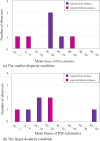Interaction of disparity size and depth structure on perceived numerosity in a three-dimensional space
- PMID: 32240209
- PMCID: PMC7117681
- DOI: 10.1371/journal.pone.0230847
Interaction of disparity size and depth structure on perceived numerosity in a three-dimensional space
Abstract
The number of elements in two stereo-surfaces parallelly overlapped in depth is overestimated compared to that in a single flat surface, even when both have the same number of elements. Using stereoscopic pairs of elements, we evaluated two hypotheses on the overestimation: one that a higher-order process, forming a background surface, increases the number of perceived elements, and the other that the number of elements potentially occluded by the elements on a front surface is taken accounted for. The data from four experiments showed that (a) when binocular disparity between (or among) stereoscopic elements was small, the overestimation occurred for the stimuli we used-a two-surface-overlapping stimulus, where the likelihood for the process to operate was manipulated by changing the averaged luminance of each surface, a volumetric stimulus, where the likelihood for the background surface to be formed would decrease, and a two-non-overlapping-surface stimulus, where the surfaces in depth were not overlapped-, and (b) when binocular disparity was large, the overestimation occurred for the two-surfaces-overlapping stimulus, when the averaged luminance of the two surfaces were the same, and for the volumetric stimulus, but diminished for the surface-overlapping stimulus, when the averaged luminance differed between the surfaces and for the surfaces-non-overlapping stimulus. These results cannot be explained either hypothesis only. We explain the results by postulating that the sensory system processing disparities of elements interferes with that estimating the number of elements, resulting in an overestimation of the elements in a stereo-stimulus, and the disparity range within which the interference occurs may depend on the stimulus depth structure.
Conflict of interest statement
The authors have declared that no competing interests exist.
Figures









Similar articles
-
Overestimation of the number of elements in a three-dimensional stimulus.J Vis. 2015;15(9):23. doi: 10.1167/15.9.23. J Vis. 2015. PMID: 26230985
-
Monocular and binocular edges enhance the perception of stereoscopic slant.Vision Res. 2014 Jul;100:113-23. doi: 10.1016/j.visres.2014.04.012. Epub 2014 May 5. Vision Res. 2014. PMID: 24802594
-
Magnitude of perceived depth of multiple stereo transparent surfaces.Atten Percept Psychophys. 2015 Jan;77(1):190-206. doi: 10.3758/s13414-014-0746-8. Atten Percept Psychophys. 2015. PMID: 25120178
-
Contour completion through depth interferes with stereoacuity.Vision Res. 2002 Aug;42(18):2153-162. doi: 10.1016/s0042-6989(02)00126-8. Vision Res. 2002. PMID: 12207976
-
Coarse-fine dichotomies in human stereopsis.Vision Res. 2009 Nov;49(22):2653-65. doi: 10.1016/j.visres.2009.06.004. Epub 2009 Jun 9. Vision Res. 2009. PMID: 19520102 Review.
Cited by
-
Effect of 3-D depth structure, element size, and area containing elements on total-element overestimation phenomenon.PLoS One. 2024 Feb 27;19(2):e0299307. doi: 10.1371/journal.pone.0299307. eCollection 2024. PLoS One. 2024. PMID: 38412148 Free PMC article.
-
Characterizing Human Perception of Speed Differences in Walking: Insights From a Drift Diffusion Model.eNeuro. 2025 May 2;12(5):ENEURO.0343-23.2025. doi: 10.1523/ENEURO.0343-23.2025. Print 2025 May. eNeuro. 2025. PMID: 40246554 Free PMC article.
-
Numerosity Comparison in Three Dimensions in the Case of Low Numerical Values.Brain Sci. 2023 Jun 17;13(6):962. doi: 10.3390/brainsci13060962. Brain Sci. 2023. PMID: 37371440 Free PMC article.
References
-
- Oyama T. Hitome de nankonomono ga mieruka. [How many things can be seen at a glance] (in Japanese). Bessatsu Science. 1978; 56: 31–41.
Publication types
MeSH terms
LinkOut - more resources
Full Text Sources

